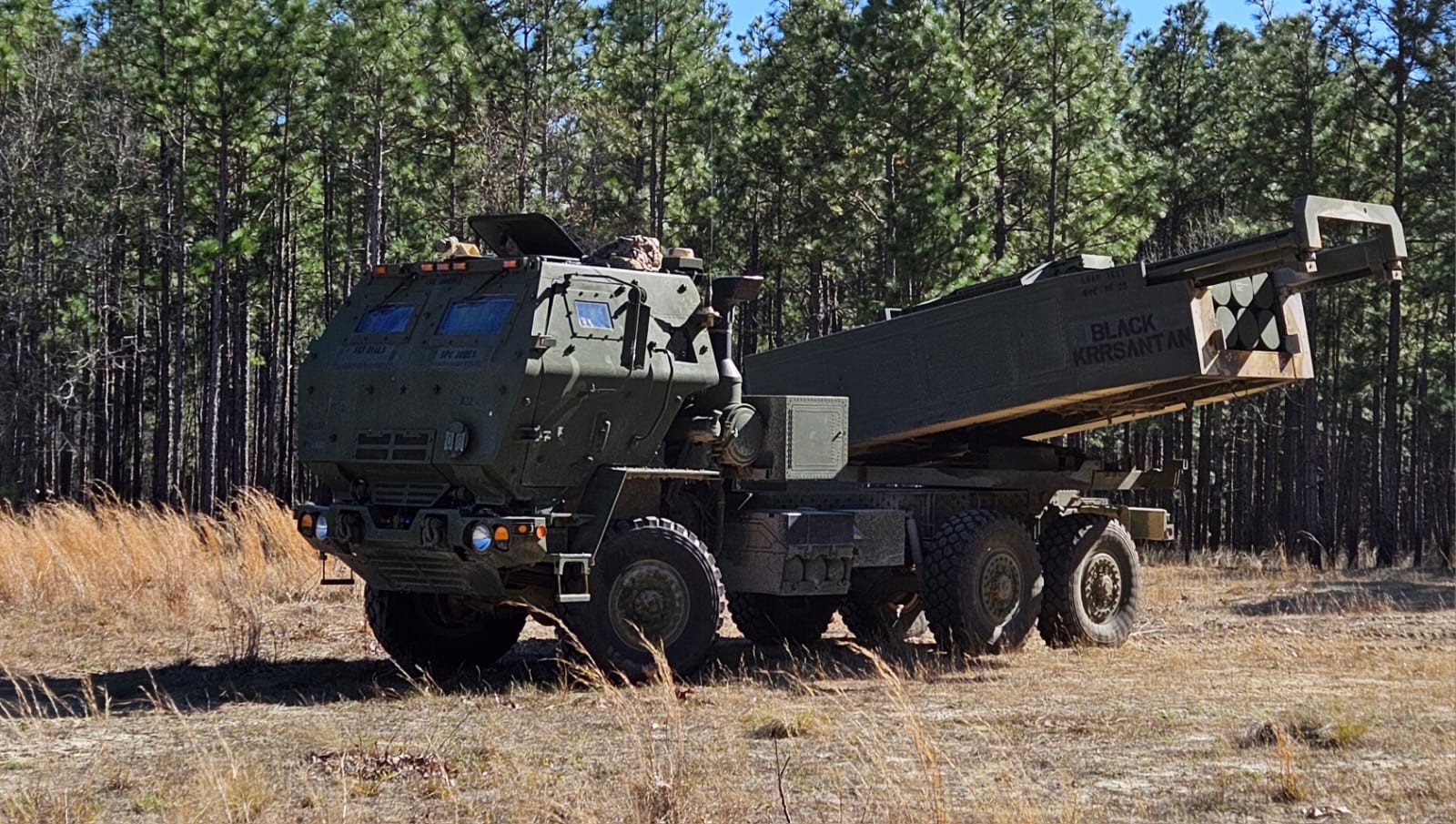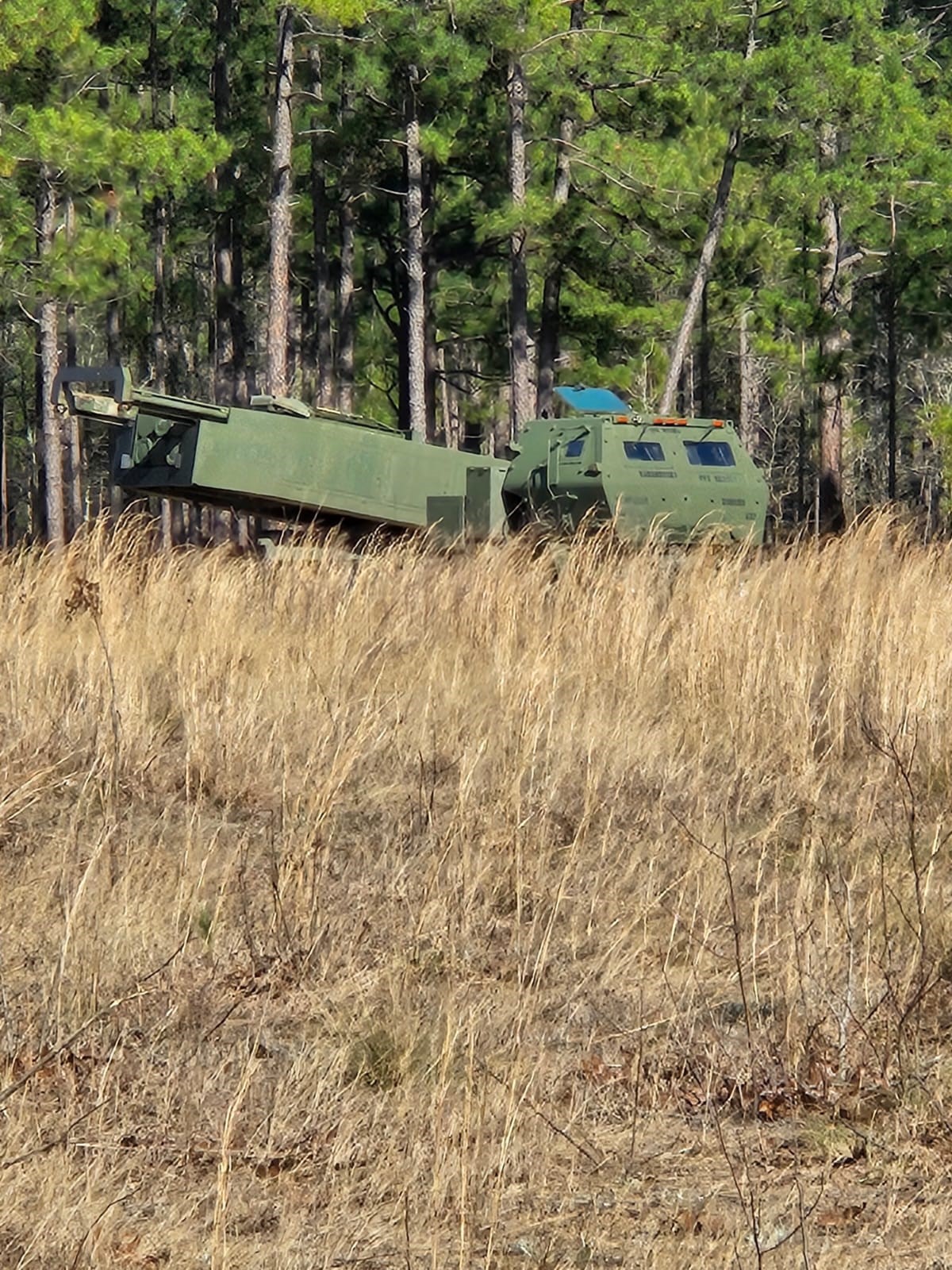Back to Basics: Massing Multiple FA Units (DIVARTY & FA Brigades)
Back to Basics: Massing Multiple FA Units (DIVARTY and FA Brigades)
CPT Matthew Rambin, Brigade Fire Control Officer
In March 2023, 18th Field Artillery Brigade participated in 82nd Airborne Division Artillery’s (DIVARTY) Basepiece Live Fire (BPLFX). This was DIVARTY’s first live fire with all 3 Battalions since 2004. 18th FA Brigade supported this effort as a General Support-Reinforcing HIMARS Brigade in support of 82nd DIVARTY’s mission. The two main training goals of the exercise were to integrate with another FA HQ, and exercise changes in support relationships to reflect what might be seen on the modern battlefield. The exercise consisted of two days of rehearsals followed by a live fire day for the howitzers. The HIMARS shot dry for the duration of the exercise.
18th FA Brigade is XVIII Airborne Corps’ rapidly deployable long range precision fires formation. The Brigade is equipped with M142 High Mobility Artillery Rocket System’s (HIMARS) and can provide rocket and missile fires from 15-300km in support of operational objectives. A Field Artillery Brigade conducts corps-level strike operations and augments division level shaping operations. A FAB can serve as the force field artillery headquarters (FFA HQ) for a Corps or JTF, or the counterfire headquarters (HQ) for a JTF, Corps, or Division. 18th FA Brigade has repeatedly demonstrated the ability to deploy firing elements down to the platoon level and conduct fire mission processes over extensive operational distances from headquarter elements to the firing elements.
82nd Airborne Division Artillery (DIVARTY) brigade level command that plans, prepares, executes, and assesses fires using precision and area munitions for the division. The DIVARTY is the force field artillery headquarters for the division. 82nd DIVARTY currently has 3 composite FA Battalions organic to it with firing capability to 40km and can integrate all forms of Army, Joint, and Multinational fires, and conduct targeting.
Over the past year 18th FA Brigade has begun conducting exercises with 82nd Airborne Division Artillery (DIVARTY) and the 82nd Airborne Joint Air Ground Integration Center (JAGIC) to build proficiency being supported by and supporting another Field Artillery Headquarters (FA HQ). This paper will explore the integration of FA Brigades with a DIVARTY HQ, command support relationships used, technical hurdles faced, and knowledge gaps encountered throughout the exercise.
Scenario: HIMARS Support to a Division
In a large-scale combat operations fight (LSCO) there are numerous scenarios where an FA Brigade would-be supporting a Division. During joint forcible entry (JFE), 18th FA Brigade would-be general support to XVIII Airborne Corps, providing shaping fires prior to the JFE and Joint-Suppression of Enemy Air Defenses (J-SEAD) fires in support of the JFE and the Corps’ objectives. Additionally, one HIMARS Battalion might be reinforcing to the 82nd ABN Division to directly provide the shaping fires they need prior to the JFE. After the JFE is conducted a HIMARS Battery could be airlanded as a Direct Support artillery unit to the JFE Brigade from the 82nd to shape their objectives as they expand their lodgment and prepare for follow on missions.
shaping fires they need prior to the JFE. After the JFE is conducted a HIMARS Battery could be airlanded as a Direct Support artillery unit to the JFE Brigade from the 82nd to shape their objectives as they expand their lodgment and prepare for follow on missions.
Scenario: Division Support to a Field Artillery Brigade
Another scenario exercised was if an FA Brigade, as the counterfire headquarters, had a howitzer artillery Battalion reinforcing the Brigade to service counterfire targets that do not warrant a rocket or missile. As the counterfire headquarters, the duties include plan and coordinate sensor management (ATP3-09.24). The counterfire HQ’s can position all sensors in its area of operations, and having a reinforcing howitzer artillery Battalion allows a counterfire HQ’s to service targets at all ranges.
Command Support Relationships Explored
In the latest exercise, the 18th FA Brigade and the 82nd DIVARTY exercised three main support relationships, Reinforcing (R), General Support-Reinforcing (GS-R), and Direct Support (DS). Reinforcing is a support relationship requiring a force to support another supporting unit (FM 3-0). Only like units can enter a reinforcing support relationship. In a reinforcing relationship, calls for fire are answered in priority for the reinforced FA unit, a liaison is furnished to the reinforced FA unit and is positioned and has its fires planned by the reinforced FA unit. General support-reinforcing is a support relationship assigned to a unit to support the force as a whole and to reinforce another similar-type unit (FM 3-0). The first priority of a FA unit assigned a GSR support relationship is to furnish artillery fires for the maneuver force as a whole; the second priority is to reinforce the fires of another FA unit. In a GS-R relationship calls for fire are answer in priority for the supported unit, the FA HQ, and the reinforced unit. A liaison is furnished to the reinforced FA unit HQ and is positioned and has its fires planned by the supported unit. Direct support is a mission requiring a force to support another specific force and authorizing it to answer directly to the supported force's request for assistance (JP 3-09.3). Direct support is a support relationship requiring a force to support another specific force and authorizing it to answer directly to the supported force's request for assistance (FM 3-0). A FA unit in DS of a maneuver unit is concerned primarily with the fire support needs of only that unit. The FSE of the supported maneuver unit plans and coordinates fires to support the maneuver commander's intent. During the exercise we were able to effectively exercise all command support relationships. 18th FA Brigade reinforced the 82nd during a DIVARTY time on target mission, HIMARS Batteries were direct support to each 82nd Brigade to reinforce them with fires and 18th FA Brigade was GS-R to 82nd DIVARTY during a SEAD schedule of fires.
Technical Challenges
During the exercise communication between 18th FA Brigade Fire Control Element (FCE) and DIVARTY’s FCE was primarily upper-TI, and secondary FM- Digital. 18th FA Brigade and the HIMARS Battery’s communicated via FM-D and FM-V with the artillery Battalions. Throughout the exercise, participating units faced few technical hurdles. First, was a HOPSET issue. HOPSET refers to where communications are conducted over multiple frequencies (up to 999) that change rapidly in a predetermined pattern. While all units are on the same monthly COMSEC (encryption) for voice and digital communications, HOPSET can vary from Corps to Division and Division to Division. Within a HOPSET, units are assigned communication nets to accomplish their missions for example Command, Fires, Admin, Logistics, etc. This was an unanticipated hurdle because the assumption was HOPSETs were universal like COMSEC. In the scenarios we faced where HIMARS Battery’s had to communicate directly with DIVARTY or FA Battalion FDC’s, we were initially unable to communicate due to different HOPSET’s loaded. We quickly learned that on our two channel radios, we could load different HOPSETs allowing units to talk within that HOPSET to corresponding units. For example, on channel 1 we had XVIII ABN Corps HOPSET loaded, so we could talk within 18th FA Brigade, on channel 2 we had 82nd ABN HOPSET loaded so we were able to talk directly to Battalion FDC’s.
Another issue faced was having to integrate AFATDS communications networks. Communications cards for Brigades and Battalions are often built, made the standard operating procedure (SOP), and then not changed. In the communications diagrams there is often not space built for reinforcing or attached units. This is particularly true for AFATDS networks. AFATDS networks are built down to the Battalion and Battery level and then codified in the SOP. In the scenario where a platoon of HIMARS is direct support to a Division space must be made in the communications diagram for the Platoon FDC. A Platoon Operations Center (POC) or a Battery Operations Center (BOC) is a necessity when attaching HIMARS to another unit because HIMARS uses DCOMMS as the primary digital communication method to send fire missions to the launcher. DCOMMS hardware is only MTOE’d to POCs and BOCs and therefore limits who can send missions digitally directly to a launcher.
Knowledge Gaps
While the artillery branch speaks a universal language, there are some differences in tactics, weaponeering and planning for HIMARS launchers. First, HIMARS and MLRS fight in a different manner then howitzers do. HIMARS and MLRS typically operate under a “shoot and scoot” mentality. HIMARS spend their time in a hide site typically within 100 meters of their firing point when able. When a launcher receives a mission, it moves from its hide point to the firing point, drives on heading,

the launcher module lays on the target and the crew fires the munition. After the munition is fired the launcher will stow the launcher module and move back to their hide point, or to the reload point if necessary. In the howitzer world a fire mission
can be sent down to a howitzer and the crew can lay the tube on the target, report up laid and remain laid on the target for as long as necessary. For HIMARS, the launcher should not remain laid on target for long periods of time for several reasons. First, it places strain on the hydraulic system used to raise and lower the Launcher Module, secondly you are exposing the launcher away from its hide site for a longer than necessary. Second, HIMARS are typically on the enemy’s High Value Target List (HVTL). Deliberate thought must be places in the munitions used to action a target. HIMARS munitions have a min range of 8-15 kilometers, and they create a large signature, both visible and on radar when shot. Weaponeering must be appropriate for the target at hand so as to not expose a launcher or engage an insignificant (or non-High Payoff) target. HIMARS must be employed appropriately to justify the risk to a critical weapon system. Finally, HIMARS Platoons should be allocated a 3 kilometer by 4-kilometer operational area (PAA) in order to doctrinally be able to have adequate area for 3 firing points per launcher, a hide site withing 100m of each firing point and 2 reload points per platoon far enough away from firing points to avoid counterfire. When HIMARS are attached to a Division deliberate planning must be done to ensure there is sufficient area for HIMARS to operate and conduct survivability moves.
Conclusion
The Army has made the Division the unit of action and units of all types may be attached or tasked to support the Division depending on the mission requirements. This is especially true for artillery. Divisions currently do not possess the organic capability to shape their deep area which will require HIMARS or MLRS units to service their targets. To have the most responsive fires, FA units must be able to rapidly adjust to changes in support relationships to meet the mission set. FA Brigades and DIVARTY’s working together will increase in the future as the Army trains for LSCO. By beginning DIVARTY and FA Brigade integration during home station training units can rehearse and rectify issues prior to CTC rotations or deployments. Seamless integration of rocket and howitzer fires at echelon requires that the units understand support relationships, the technical challenges, and how the systems are employed to make the FA branch more cohesive and able to meet any mission set.
CPT Rambin is currently serving as the Brigade Fire Control Officer for 18th Field Artillery Brigade. His previous assignments include Battalion S4, Battery executive officer and fire support officer. He was commissioned in 2017 through the Norwich University ROTC program.
